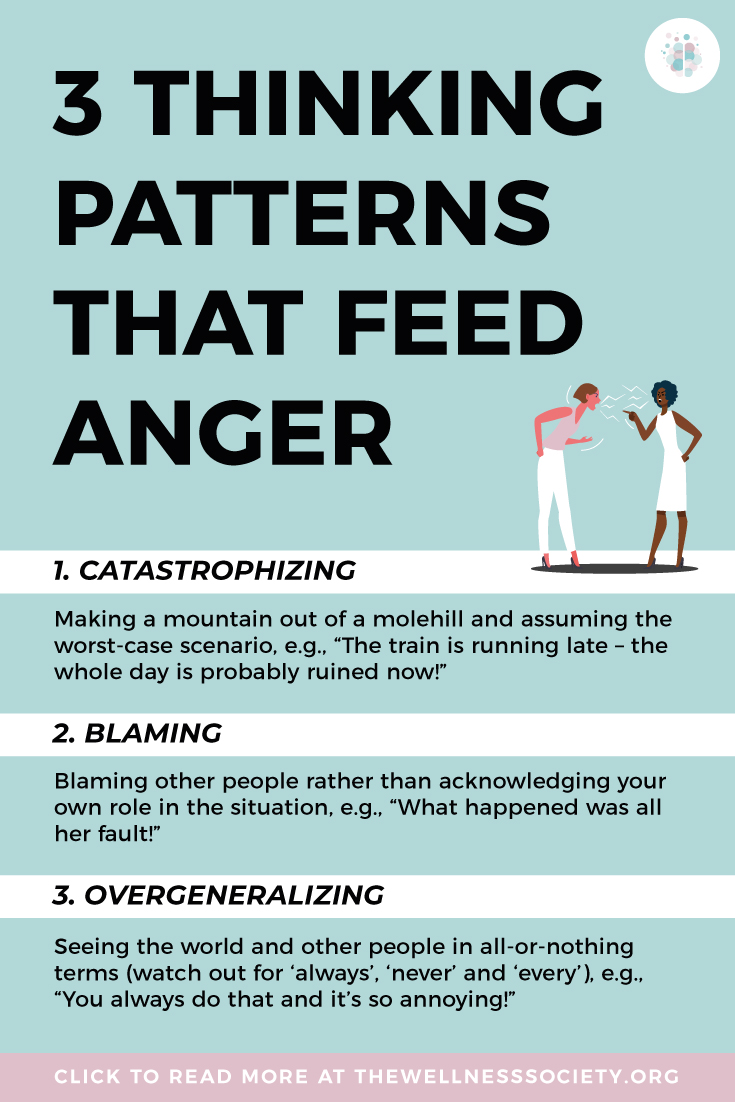How to deal with anger? We all experience anger – it’s a normal emotional response to either real or imagined threat. It helps us by alerting us to potential danger, and by preparing us to confront it by fighting, fleeing, or freezing. When you’re dealing with anger, your brain readies you for a fight by increasing your rate of breathing, focusing your sensory perceptions, and elevating your heart rate.
Studies suggest that some people may inherit the disposition of being 'short tempered'. However, anger may also be learned through the process of modeling, which occurs by observing how family or friends react when dealing with anger.
Additionally, research has also shown that negative life experiences such as trauma and stress can negatively impact anger reactions.
6 Tools for How to Deal with Anger
Tool 1: Understand Your Anger Triggers
Monitor events in your life that trigger irritation, frustration, annoyance, or anger.
Keep track of people, places and situations that predispose you to losing your cool.
Once you become more familiar with your anger triggers, you’ll be better prepared to deal with them.
You can do this by using our free Anger Worksheets - access them using the form below.
Tool 2: Notice Your Physical Reaction
People often say that their anger “just seems to come out of nowhere”, when in fact there are several physical signs that provide clues that anger is rising.
Recognizing and understanding these signs helps with successful anger management.
Common anger signs include:
- Shallow or rapid breathing
- Elevated heart rate
- Tensing of muscles
- Clenched fists
- Feeling hot, flushed, or sweaty
Next time you feel your anger levels rising, practice tuning into your body and seeing what you notice.
Tool 3: Identify Unhelpful Thoughts and Beliefs
Studies suggest that the feeling of anger is often influenced by the thinking pattern a person has about a triggering situation.
This mental interpretation can be influenced by one or several thought biases that could quite easily encourage an unhelpful conclusion about the event, and an exaggerated anger response.
Examples of thought biases that feed anger include:
- Catastrophizing: Making a mountain out of a molehill and assuming the worst-case scenario, e.g., “The train is running late – the whole day is probably ruined now!”
- Blaming: Blaming other people rather than acknowledging your own role in the situation, e.g., “What happened was all his fault!”
- Overgeneralizing: Seeing the world and other people in all-or-nothing terms (watch out for ‘always’, ‘never’ and ‘every’), e.g., “You always do that and it’s so annoying!”
Psychologists call these unhelpful thinking patterns "cognitive distortions". For plenty of practical tips and tools for dealing with cognitive distortions, be sure to check out our free book The Framework: Understanding and Reducing Stress, Autostress and Anxiety. Additionally, you might find these books on anger management very useful.
Tool 4: Uncover the Emotions Behind Anger
Emotions are classed as primary emotions and secondary emotions.
Primary emotions are already present at birth and are experienced first in any given situation.
Secondary emotions occur as the result of the reaction to the primary emotion.
Therefore, secondary emotions are an emotional reaction to having the original emotion. Secondary emotions are learned behaviors, usually from family and society, and they’re based upon experience.
An example of this is the statement of, “boys don’t cry”. A boy who has learned this belief and understands this as true may replace genuine feelings of sadness with anger. Therefore, for effectively dealing with anger, it’s useful to to first explore the original feelings behind the reaction.
Tool 5: Manage Your Behavioral Reaction
Contrary to enduring misconceptions about dealing with anger, the act of venting by using a physical outlet, such as screaming into a pillow or hitting a punching bag, does not actually reduce the level of anger.
Studies indicate that venting may actually increase anger levels, and even lead to increased aggression in future situations.
Useful strategies for dealing with anger include:
- Taking a time out
- Practicing a breathing exercise
- Exercise
- Using a distraction technique
Tool 6: Practice Healthy Communication
Assertive communication is the healthiest form of communication because it’s a way of expressing feelings, thoughts, and beliefs in an open, yet honest manner without violating the rights of others.
Assertive communication requires that the person state what occurred as a set of factual claims, instead of judging, shaming, blaming or negatively labeling.
This allows a person to share how the event impacted them without lashing out at others.
An example of a tool from assertive communication is the use of “I-statements”.
For example, instead of saying, “You’re a jerk”, an I-statement would be, “I felt disrespected when my book is taken without permission, could you please ask me next time?”.
A 3-step framework for practicing healthy communication is: “I felt...”- “when...”- “next time...”.
It should also be noted that abusive anger – any kind of shouting and screaming – is a form of verbal abuse. If you’re prone to abusive anger, it's important to try practicing paced breathing before speaking.
A Toolkit to Help You Manage Challenging Emotions
Our self-guided program includes tools from CBT, DBT, ACT and more, so you can discover what works best for you. Check out The Mental Wellbeing Toolkit today – it's "like 10 therapy sessions in one."

About Portia
Portia Allie-Turco is a Clinic Director, Program Coordinator and Lecturer in the Counselor Education Department at SUNY Plattsburgh, New York. As a Licensed Mental Health Counselor her professional experience includes working with individuals, couples and families. She has worked in conjunction with the Clinton County Family Court System as a conflict resolution mediator. Her current focus includes working with First Responders in Critical Incident Stress Debriefing and as a trauma consultant for the Clinton County Department of Social Services. She provides several programs for adults and youth one of them being C.H.I.L.L., an anger management group for at-risk-youth.Pin For Later




